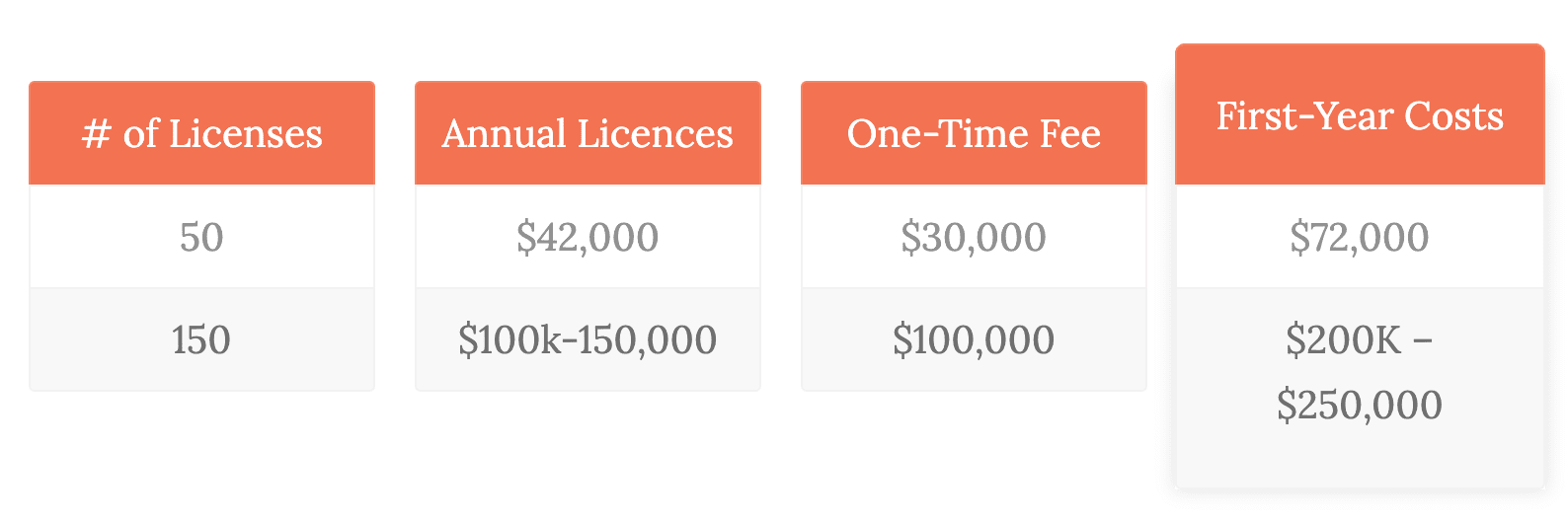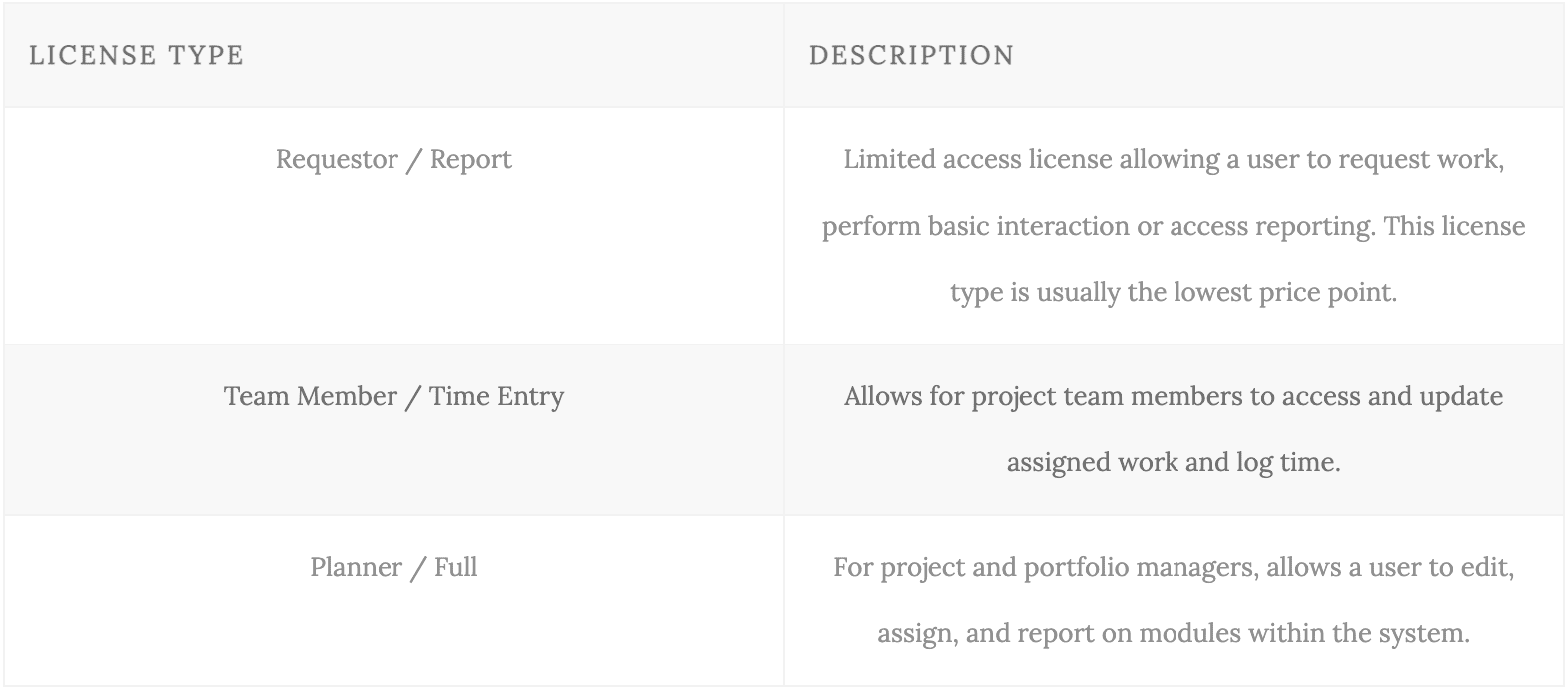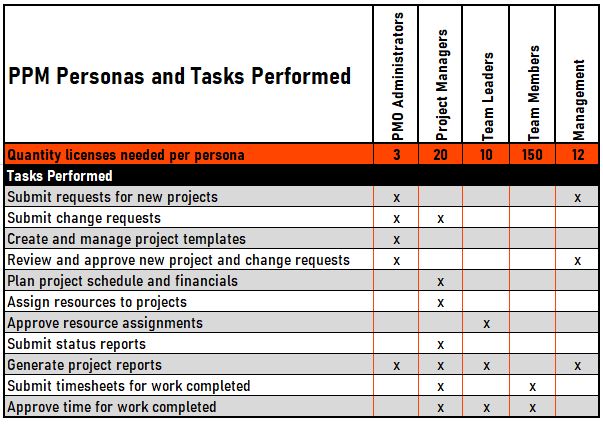If you are a Project Management Leader, you have probably got a mess to clean up. Maybe things keep going off track, maybe you have no easy way to measure what’s going on, or maybe you are just tired of struggling through portfolio reports at midnight when you yell, “There has to be a better way!” The good news is, there is a wide variety of Project and Portfolio Management (PPM) solutions that can help you more effectively manage your project delivery. Better yet, these PPM solutions have become very accessible, are easy to use, and powerful. But of course, as soon as we start considering tools, the first question that comes up is: What is this PPM tool going to cost me?
Your ultimate bill for a PPM can be surprisingly low – or surprisingly high. Unfortunately, it can be difficult to get a clear bottom-line answer for the total cost of a solution – and even then, the costs you are probably thinking of are only part of the picture.
So, how much will a PPM cost me?
At Kolme Group, our team has built, run and helped to improve project management organizations around the world. In doing so, we have facilitated the selection and implementation of various PPM tools, we are well acquainted with the process of getting to the costs involved.
Like you, we have faced the challenge of trying to understand the true costs of implementing a PPM solution. That is why in this article, we are giving a straight and simple answer as best we can on this complex topic.
Keep in mind, there are many components that will impact your costs. So, we will walk you through the most impactful factors and a few examples. We will also share tips for managing your implementation costs and getting the most value from your PPM investment.
Please Note! These examples are by necessity general in nature, and will likely differ from your unique use case.
Furthermore, the cost estimates we will share in this article are very conservative – you will likely find that you can negotiate better pricing.
The simple (and incomplete) answer
PPM software and basic onboarding costs are a starting point but not the entire picture. Below, we’ve chosen two starting point examples, for each of the three tiers, but read on to discover the “true costs” you’ll be looking at.
An “Enterprise Class” PPM Solution’
Clarizen, Clarity, Workfront, ServiceNow PPM, etc
Full-featured tools like these will likely cost $60-$100 per full-function user, per month for licensing. In addition, you should plan for a one-time services cost for basic configuration and onboarding assistance. This could range from $30,000 – $100,000 or more, depending on your organization’s complexity.

Simple Task Management Tools
Asana, Trello, Monday.com
Tool such as these are used mostly to organize task activities with no integrations or customized reports. They will cost $16 – $25 per user, per month for licensing. These typically do not involve or even have options for external services for configuration or implementation. You should, however, factor in your own time to learn the tool and the resource time needed to train your team on how to use it.

Mid-Tier Systems
SmartSheets, MS Project O365
These fit somewhere in between the two types previously mentioned. These systems will run you around $25 per user, per month, though implementation costs can be highly variable in this tier. If you have the time and the experience, you can decide to implement it yourself, or engage an implementation partner and pay $10,000 – $50,000 for professional onboarding support.

Software cost estimates, above, reflect typical “list prices” which can often be negotiated down especially if you have larger volumes, have a pre-existing relationship with that particular software vendor, or commit to a longer contract (1-3 years).
Pro Tip
PPM license costs can be highly negotiable in certain circumstances. If you are able to negotiate lower costs, be sure those discounts apply to any additional licenses in case you need to grow.
The Basic Onboarding costs we have described so far are for relatively straightforward deployment of the solution and getting the team onboard. Costs in these ranges would not typically yield a fully customized solution for your organization (integrations, configurations for your specific business processes, etc.).
Basic Onboarding typically includes:
- Initial setup and configuration of the system
- User account import and permissions setup
- Basic project lifecycle configuration
- Basic financial configuration
- Minimal report development
- User training, onboarding and go-live support
Please Note! You can spend 10% or 10x this amount depending on your needs. As you will see below, there are a few key areas that can really increase or decrease inflate your costs.
But… I can get “free” or cheap bundled licenses!
Yes licensing costs, especially for the more full-featured PPM tools, can be highly negotiable depending on volume. This can be an important factor for tool selection and consideration, but be cautious! Unless you are a small shop using a freemium service, ‘on the house’ licenses are never really going to be “free”.
Many product companies use a bundling tactic to expand their software footprint. Software companies often bundle PPM software with other products or services to give you the impression you’re getting it for free, or at least at a steep discount. In these cases, a sweetheart license price structure can seem like a great deal…at first. In the long run, though, you may find you are better off paying more for a system that actually meets your needs rather than struggling with the wrong tool just because you got a “good” deal.
A previous client had gone through the pain of implementing not just one, nor two – but three different resource management tools before they found a good fit. The first tool was selected because it was an add-on to their ERP, and you guessed it!… licenses were offered at a steep discount. The second tool was “free” as part of a bundled enterprise software suite and they fell for the bundle tactic.
Unfortunately by the third tool, the time (both in duration and level of effort) coupled with the erosion of their credibility with their stakeholders, ended up costing them many times over the license discount they received. Not to mention, the lost opportunity costs during the 4-year journey to ultimately find the right tool.
The lesson here, is that while license cost is an important consideration, there are other costs to consider, both hard and soft. More importantly, if the tool does not meet your needs, you’ll never gain the value from it to justify those discounted licenses.
What really impacts your PPM Tool costs?
There are a few key areas that have the greatest impact on your overall PPM tool costs. Understanding these areas can help you identify which items on your PPM wish-list are going to cost you the most so you can start to understand your must-haves versus your nice-to haves from a cost perspective.
Key cost areas:
- Licensing Types
- Integrations
- Customization & Automation
- Unique Use Cases
- Support and Enablement Approaches
- User Training, Onboarding and Go-Live Support
Licensing
THE LICENSE TIER OR LICENSE TYPE YOU CHOOSE CAN IMPACT YOUR LICENSING COSTS BY -50 TO +100%. TAKE THE TIME TO FIGURE OUT WHICH LICENSE LEVEL YOU REALLY NEED, RATHER THAN LEAVING IT UP TO THE SUPPLIER.
PPM licenses are typically broken out into different types/tiers depending on the user role in the system. These types will vary by PPM, but typically include:

Pricing can be dramatically different between the license types and this can have a huge impact on your costs. For example, Requestor or Team Member licenses can cost a fraction compared to those of the Planner tiers.
Pro Tip
When drafting out your PPM scope, take the time to identify each “persona” in your organization and what they need to do in the system.
Understanding each persona needed in your organization will help guide the conversation with prospective PPM suppliers and ensure the right license level for each of your personas. You will want to avoid moving through the sales cycle only to find out that you purchased the wrong license types.
We have had some customers who ended up having to push through a last-minute PO to increase their license counts right before go-live since they incorrectly assumed the permissions given available to the roles in the system. The sponsor was not pleased to learn a day before go-live their annual revenue was going to increase by double.
In the reverse scenario, we worked with a different customer that had surveyed stakeholders within the organization and largely inflated the number of licenses needed. It ended up taking 5 years of increased user-adoption throughout the organization to match the number of users in the system to that of the license counts in the contract purchased.
Below is a simplified version of a how you might map out a persona matrix to help quantify your license needs:

Figure 1 – Sample Persona Matrix to help quantify license requirements
Integrations
INTEGRATIONS CAN ADD $10,000-$50,000 TO YOUR IMPLEMENTATION COSTS, PER INTEGRATION. VERY SOPHISTICATED CUSTOM INTEGRATIONS CAN BE $100,000 OR MORE
Integrations with external systems is another possible large impact to your PPM cost. Projects don’t live in isolation inside your organization and consequently neither does your project data. You can increase value when adding automation and centralized reporting by integrating your PPM with other systems, but it can get really expensive.
Typical integration points include:
- Directory services for identity + access management automation
- ERP for budgeting, actual costs, and revenue forecasts
- File repository for document collaboration
- Agile tools
- Ticketing or IT System Management tools for project intake or reporting
- HR systems for user data and time off
- Data warehouse or reporting services
Integrations also vary highly in costs depending on the method used to build the connection. The right method for you depends on your budget but you’ll also want to assess the volume, frequency and uniqueness of your integration requirements.
Typical integration methods, from least to most costly, are:
FILE-BASED
Are triggered manually for infrequent updates, or for frequent updates, use automated scripts, emails or basic automation. These are a good option for an inexpensive start and provides an opportunity for using the tool before investing time + cost for a complex integration.
COMMERCIAL MIDDLEWARE
These integration platforms are nice if you have simple requirements. Often, PPM providers will have favored platforms or may have their own middleware platform. Common platforms like Workato, Jitterbit, SnapLogic or Zappier can give you a reasonably quick start to getting your integration up and running. Keep in mind, you may still have some custom development + another platform added to your cost outline.
CUSTOM API
Typically require the most development resources, but they’ll grant the you powerful control over the integration. If you can build one without commercial middleware, that’s one less ongoing cost to worry about.
Pro Tip
Discover if your organization has the capability to develop in-house integrations. This will save you a significant investment in professional services, and also give you the ability to adjust/expand on that integration in the future.
Regardless of your approach, be sure you have a clear understanding of what you want from each integration, including what data flows, which direction, and how often. This will help ensure you get what you need and helps your provider give the most accurate cost based on those requirements.
Customization & Automation
CUSTOMIZATIONS AND AUTOMATION CAN ADD A LITTLE (~10%) OR A LOT (~2X OR 3X) TO YOUR GENERAL ONBOARDING COSTS
Full-featured PPM tools offer amazing levels of customization and automation to increase your organizations efficiency. In fact, the more important question is not can the tool automate this process, but should it automate this process.
Our advice: Start with the minimum amount of customization and automation – focus on critical simple processes and fundamental adoption of the tool. As your users become more comfortable with the system, you can add additional functionality and automation. This makes onboarding easier and increases your short + long-term adoption.
A common example of this “minimum lovable product” approach is seen during new project requests. Often, a PPM tool is implemented to support the consolidated project intake and review process across previously siloed departments. While providing enormous value to an organization, some get excited and roll-out too much, too early on.
Typically, clients add sophisticated workflow automations before the organization has adopted the simple concept of the aforementioned, this consolidated project intake process..
Pro Tip
It’s best to start simple and then add more after adoption is successful.
When considering your PPM needs, be aware – the more customization and automation you add, the higher the implementation cost.
You may also want to research how easy the tool is to learn from a configuration standpoint. This way, you can understand the administrative overhead required to enhance those configurations later on, whether it be the supplier, partner or even your own team.
Unique Use Cases
IF EACH USE CASE (ADDITIONAL DEPARTMENT) YOU ADD IS COMPLETELY UNIQUE, ESTIMATE ANOTHER +50% TO +100% FOR EACH ADDITIONAL DEPARTMENT YOU ONBOARD.
Another possible significant impact on implementation costs are the number of unique use cases, or unique team processes, that are joining the tool.
For example, the configuration and onboarding effort may not be appreciably different if you have one common way of working for 100 people or 1,000 people. But, if you have five departments that each have their own unique project lifecycle, financial or resource management processes, that can be 5x more work to implement because it acts as if you’re really onboarding five different organizations.
This is why, implementing a PPM tool is a great excuse to apply some standardization across the organization. Even streamlining simple things like common project KPI tracking, status reporting templates or reporting can not only reduce the cost of your implementation but also provide value to the organization through standardization.
Pro Tip
If it’s not possible to standardize, then you can improve your implementation success by onboarding one business unit at a time. This gives you a chance to learn lessons from each successive department’s onboarding.
Support approach and involvement
Ongoing support and enhancements can be a likely impact to your implementation cost as you decide how involved you want your team to be. Most PPM tools provide various training mediums for project team members to learn system administration and configuration. This will allow you to successfully own the system and configuration after implementation. Some providers will even encourage an “enablement” approach during onboarding, allowing your team members to be hands-on during implementation, potentially reducing some of costs by taking on the less technical aspects of onboarding. This includes UI clean-up and user permissions.
Of course, the more resources you dedicate to system implementation plus ongoing support, the lower your supplier implementation cost. However, this can impact your timeline. Keeping the pros and cons in mind, understand that it will be a better long-term investment but you have to have the resources available on your team to focus on learning these skills and be ready to invest in them.
The hidden PPM tool costs that will get you
Although the costs described above can have the biggest impact on your overall PPM implementation budget, there are areas that can take a surprising amount of effort by your supplier or your team and cost you more than planned.
Data Migration
Migrating mass amounts of data for historical or in-flight  work can be surprisingly challenging and time consuming. Even if the data is quality (which usually isn’t the case) you’ll need to transform and import it, in order to make that legacy data coexist with new data. That’s a lot of work!
work can be surprisingly challenging and time consuming. Even if the data is quality (which usually isn’t the case) you’ll need to transform and import it, in order to make that legacy data coexist with new data. That’s a lot of work!
If possible, use your transition to a new PPM tool as an opportunity to start clean with new project templates, fresh budgets and data.
For example, if your organization uses Microsoft Project Pro to track project plans and your PPM tool allows you to import those plans, this does not mean you should. Your old plans are likely not consistent across all your projects or they have issues with the resource data lining up with your new, clean, PPM resource pool. Besides, most PPM systems have richer metadata on their projects that your old MS Project plan will not. So, although it may be attractive to import all your current plans, you will likely find that it is not worth the effort and best to start off fresh.
Process Development
Attempt to document your processes (project lifecycle, budgeting, etc.) in advance. If you need help developing or improving your processes, your PPM implementation partner should be able to provide assistance on best practices. Keep in mind, this type of consulting can add up quickly and deduct from your planned implementation budget. Be prepared with your processes, documented and ready to go, or with the expectation that you will need to invest in expert assistance improving your ways of working at the same time you implement your toolset.
Operational Costs
Likely, you will need to dedicate an amount of resources to administration, training, and maintenance of your new system. We typically advise to invest some amount of resource time to learn the configuration side. This way you can make configuration changes, develop reports, etc., rather than always relying on an outside partner. This is promising, but you will need to allocate ongoing resource time for these activities.

Support Costs
Be aware – different PPM providers approach and price support in different ways. Key areas to watch for are:
What are the support plans available, what SLA do they provide, and which one matches the criticality of this system in my environment?
Is administrative / configuration training free or cost money? Are vouchers available for signing up to different support levels?
Do I pay more for staging or development environments? Any required workflow or configuration tools? Or are those included?
Training Costs
Another cost that can be surprising is end-user training cost – both in the time needed to train and producing the supporting documents. Because PPM tools are often configured to support your specific project delivery processes, you will need to develop end-user training specific to each persona in your organization.
Your PPM supplier may have a standard deck to get you started but you will also want to highlight areas the tool has been configured beyond out-of-the-box and tailored for that persona’s specific business processes.
This cost may or may not be included in the PPM implementation costs and when it is, it can be significant. To save cost, you can:
-
- Go with a ‘train-the-trainer’ approach, where the suppler trains your power users or trainers, who then go on to train all your end-users.
- Develop the training in-house. This can save a lot but requires you have involved team members in the implementation – enough so they can develop the material.
- Lastly , you can record the trainings and making it part of the onboarding for new hires or for those that desire an On Demand option.
How do I keep PPM tool costs down and maximize return?
Kolme has implemented PPM tools for many clients and based on our experience, we wanted to share the following tips with you, as you prepare get to start, or re-engage, your PPM journey:
MODERATE YOUR EXPECTATIONS, SIMPLIFY YOUR NEEDS
Yes, it is exciting, but our main advice is to be pragmatic and temper your expectations. PPM tools can adapt to your organization, but they are only tools and won’t solve all your problems. If anything, they will help identify the problems in your organization.
OWN IT!
Get involved, learn the tool and be active during the implementation. Start by documenting your own processes and invest in training your own people so they can be part of the solution, if possible.
USE AN AGILE APPROACH
Start with a “Minimum Lovable Product.” If you try to implement too many features at one time you will fail. For example, if you roll out 50 features to users, they will be overwhelmed and will probably adopt none. Better to start simple and implement 5 high-value features until adopted, then gradually add layers of features after that.
INVEST IN ORGANIZATIONAL CHANGE MANAGEMENT (OCM)
Use OCM strategies for long-term success. Even the best tool in the world is not going to succeed if nobody uses it, so look into tools and techniques like Prosci© ADKAR model for managing change and helping users adopt the new system and the processes attached.
Is a PPM worth it?
A PPM tool can undeniably be a worthy investment. Even with costs involved, and some not insignificant, we still advise on having one.
As a former PMO lead for a professional services organization, I implemented a PPM tool and that Organization’s billable utilization improved by more than 20%! The next time I implemented a PPM tool for an organization, we identified and corrected erroneous CAPEX allocation of labor cost which was amounted to 30-40% of all project labor. With another client, we found that 75% of their projects did not align to their strategic objectives. And with another, we managed to save nearly a million dollars’ worth of resource effort through automation and streamlining of processes.

So, based on our personal experience implementing these tools for ourselves – and for our clients – it is definitely worth it.
What’s next?
If you are ready to go shopping for PPM tools, or revisit your existing implementation, here are a few next steps:
BUILD YOUR STAKEHOLDER COALITION
JUSTIFY THE RETURN ON A PPM INVESTMENT
IDENTIFY YOUR REQUIREMENTS
DOCUMENT A PROPOSAL FOR DEVELOPMENT AND EVALUATION
